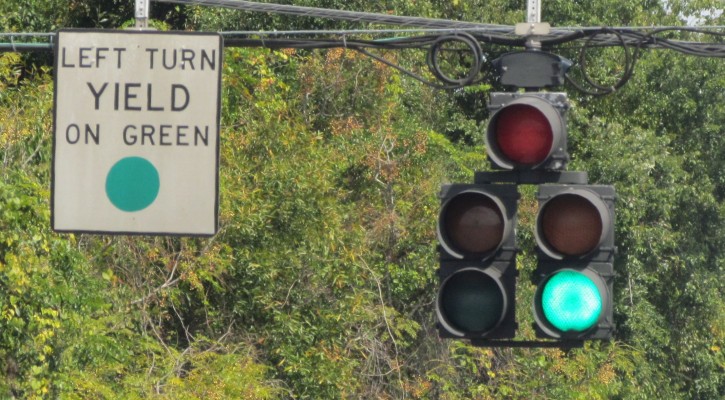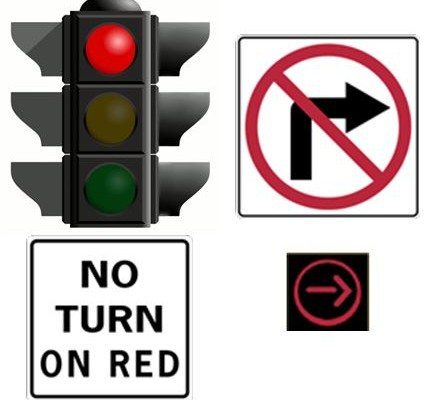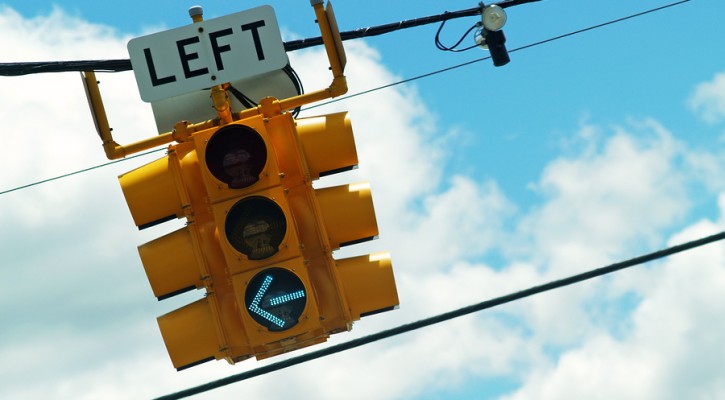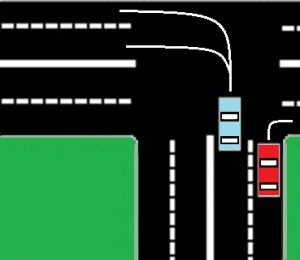Tag Archive: Rules of the road

Ask The Driving School Instructor: Left Turn On Green
October 13, 2014
Question: I’m confused by the “left turn yield on green”. Who is supposed to turn first when the light turns green?
Answer: I can see how this could be a little confusing for a new driver. This sign is most often posted where there is a combination of both a left turn arrow and a standard traffic light as in the photo above. It allows traffic to turn during those periods when the green turn arrow isn’t working.
During normal or low traffic periods, the green left turn arrow won’t used at all. However, during times of heavier traffic, such as rush hours, the left turn arrow will be used along with the regular green light. The turn arrow will allow traffic in the left turn lanes to turn left. When the turn arrow turns red, the standard, round green light will light up allowing traffic in the right lanes to proceed. The sign, “left turn yield on green,” means that traffic in the left turn lane is allowed to turn but only if the oncoming lane is free of traffic.
If you’re in the left turn lane facing a standard, round green light with the “left turn yield on green” sign posted, you must wait or “yield” until the opposite lane is clear or there is a wide enough gap in the oncoming traffic to give you enough clear space to make a turn. If the left turn arrow isn’t working and traffic is heavy in the other lane, you may have to wait through the red light until the next green light before traffic is light enough to allow you enough clear space to turn left.

Ask The Driving School Instructor: Right Turn On Red
September 23, 2014
Question: What are the rules for making a right turn on red?
Answer: There are several rules and things that you must watch for when making a right turn on red.
The first and most important rule – and this is the law in all 50 states – you must come to a complete stop at the red light before making a right turn on red. Failing to obey this law gets a lot of drivers in trouble either through involvement in a crash, or by receiving a ticket for running a red light. Many drivers, at intersections where red light cameras are installed, receive a ticket for running a red light because they seem to have forgotten this law and make a “rolling right on red.” Red means stop!
Making a right turn on red isn’t allowed at every intersection. If a “No Right Turn On Red” sign is posted, it’s illegal to turn. Sometimes, when the oncoming lane has a left turn light, an electric “No Right On Red” sign will light up. It’s your duty as a driver to be aware of all signs.
Other intersections may have a red right turn arrow. Just like a red light, a red right turn arrow means you must stop. However, in some states, Florida included, it’s legal to turn right on a red arrow after you’ve come to a complete stop unless there’s another sign posted that says “No Right On Red.” If you’re unsure of what the law is in your state, check your driving manual or, to be safe, remain stopped until you get a green arrow.
There are a lot of good reasons why you must come to a complete stop before making a right turn. Intersections can be a dangerous place and most crashes in the US happen at intersections. When you stop at a red light, before turning right, check for;
- Pedestrians that may be in the crosswalk – they have the right-of-way.
- Vehicles coming from the left on a green light (including bicycles and motorcycles) – they have the right-of-way.
- Vehicles in the oncoming lane turning left on a green left turn arrow – they have the right-of-way.
- Vehicles from the right that are making a U-turn at the intersection – they have the right-of-way.
- Pedestrians and bicyclists entering the intersection from the right- they have the right-of-way.
Another issue with right turns on red involves driver courtesy and good common sense. Sometimes, in heavy traffic, when traffic is backed up to the intersection, drivers must stop at the white line before entering the intersection to avoid blocking the intersection, if the light should change. Along with obeying the law, they are actually doing you a favor by keeping the intersection clear for you if your light should turn green. When you see a driver stop on a green light before entering the intersection, don’t take advantage of them by seeing that as an opportunity to make a right turn on red. It’s illegal, rude, and could lead to a road rage situation.
You’re only allowed to turn right on red if the way is completely clear of all pedestrians and other traffic. Don’t allow yourself to get in the habit of a rolling right turn on red.

Ask The Driving School Instructor: Left Turn
September 8, 2014
Question: When making a left turn at an intersection, can you end the turn in any lane?
Answer: In most states, whether turning left or right, you must turn into the nearest lane. In other words, if you’re making a right turn from the right lane, you should turn into the far right lane of the street you are turning onto. If making a left turn, you should turn into the left lane.
Florida law is a little different from most states. Under Florida law, you must still make a right turn from the right lane into the right lane. However, when making a left turn, you may turn into “any lane lawfully available, or safe for the desired direction of travel.”
Let’s look at a scenario where it would be legal to turn left into any “lawfully available, safe” open lane. Let’s say, as soon as you turn left, you need to make a right turn into a parking lot. In that case, under Florida law, it would be legal to turn left into the far right lane as long as – and this is important – the far right lane is clear of traffic and you can safely move into that lane. If there is traffic in the lane you want to move into, you must move into the safest available lane and then move into your desired lane as soon as it’s safe to do so.
Unless you need to turn again, after making a left turn, the safest and smartest thing to do is to turn from the left lane into the left lane. Afterwards, if you need to move over into another lane, you should signal for a lane change, check to see if the lane is clear, and then move over. Remember that, under Florida law, you must use your turn signal whenever you are making a turn or when changing lanes.

